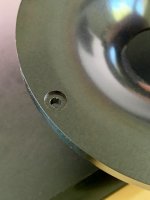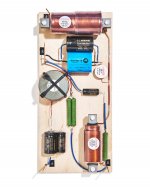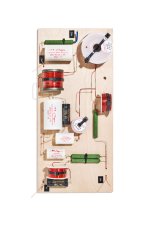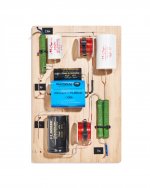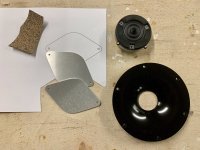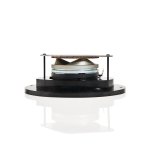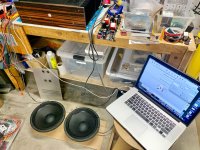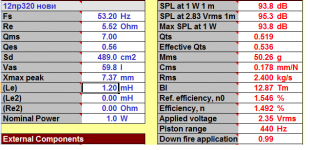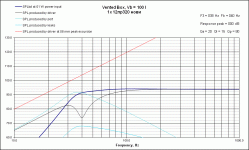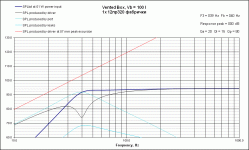Flat bottom countersink. The "low" bolts I have will look great, almost flush... Just saying for "perfection" a slightly deeper tooling, or the ultra-low-profile head is required. It would seem that the ultra-low head is easier to find in the EU...
Cap head may be a good in between, I may have some that would fit.
Cap head may be a good in between, I may have some that would fit.
Attachments
Looks good, but there are two things I am not sure about:
(1) What's the value of the blue Clarity Cap? 18 uF?
(2) Are "In-" and "W-" connected to each other below the plate?
(1) What's the value of the blue Clarity Cap? 18 uF?
(2) Are "In-" and "W-" connected to each other below the plate?
YES! Working on mids....
Also, based on a good look at the tweeter/waveguide—I think a clamping solution is really the only way to go... and fill old bolt holes on tweeter to seal, seal contact between waveguide and tweeter. The containing ring that sits on the magnet/body of the tweeter and is connected to the cone has some movement/lift...it doesn't seem to me to be secure enough mechanically to be glued to the waveguide without additional support... so, 40mm M3 bolts on order... I did have to run a tap in the waveguide threads to clean out the finish....
Also, based on a good look at the tweeter/waveguide—I think a clamping solution is really the only way to go... and fill old bolt holes on tweeter to seal, seal contact between waveguide and tweeter. The containing ring that sits on the magnet/body of the tweeter and is connected to the cone has some movement/lift...it doesn't seem to me to be secure enough mechanically to be glued to the waveguide without additional support... so, 40mm M3 bolts on order... I did have to run a tap in the waveguide threads to clean out the finish....
Looks good, too. The values of the "upright" inductors are not visible, but I guess you got these right. Nice work, keep it up!
(In the meantime you could start breaking in the woofers. It takes forever to get them to soften up... Just use a low-frequency signal that can't be heard and crank up the volume as far as it will go without running the woofers into their mechanical limit)
(In the meantime you could start breaking in the woofers. It takes forever to get them to soften up... Just use a low-frequency signal that can't be heard and crank up the volume as far as it will go without running the woofers into their mechanical limit)
See here for woofer break in: Open Source Monkey Box
I used a signal generator --> power amplifier --> woofer
If you don't have a signal generator, maybe you can use your computer playing a low-frequency test tone, set to "repeat forever".
You don't need the box or xover for this. All you need is to make sure the moving parts of the woofer are moving as much as possible so that the suspension will loosen up. The Faital 12PR320 woofers take quite a long time for break in! Don't be shy and use a lot of power power to loosen things up!
I used a signal generator --> power amplifier --> woofer
If you don't have a signal generator, maybe you can use your computer playing a low-frequency test tone, set to "repeat forever".
You don't need the box or xover for this. All you need is to make sure the moving parts of the woofer are moving as much as possible so that the suspension will loosen up. The Faital 12PR320 woofers take quite a long time for break in! Don't be shy and use a lot of power power to loosen things up!
Thanks! My F5 does need a job at the moment. It's a little sad in the shadow of M2X mono blocks.
Brilliant! I knew it was going to be nice if a photographer was going to do this. 😀
Would you be okay if I would include the sandwich photo in the OSMC documentation file?
Would you be okay if I would include the sandwich photo in the OSMC documentation file?
Okay... finally made this happen! Break-in occurring... How long is recommended Matthias?
Also wasn't totally clear on how 10 Vrms might translate to what's on the screen there... I played with db in REW and volume for max movement... It's not insane, but they are moving some air. Very nice banana friendly attachment points on those woofers btw.
(Excuse the messy bench.)
Also wasn't totally clear on how 10 Vrms might translate to what's on the screen there... I played with db in REW and volume for max movement... It's not insane, but they are moving some air. Very nice banana friendly attachment points on those woofers btw.
(Excuse the messy bench.)
Attachments
There are no strict rules for the woofer break in. Just do it as long and as hard as possible. I ran mine at 20 Vrms / 15 Hz (sine) for 24 hours, but that was just me. If you have a DVM you can use this to check the drive voltage. Even cheap DVMs will give good AC-rms readings as long as the frequency is lower than a few kHz.
(I like the bench. What amplifier board is this?)
(I like the bench. What amplifier board is this?)
- Home
- Loudspeakers
- Multi-Way
- Open Source Monkey Box
